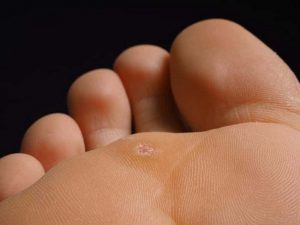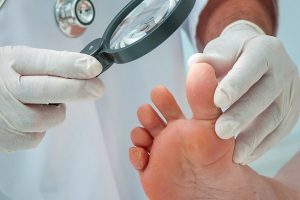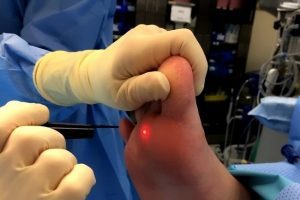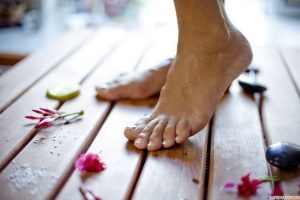Plantar warts are growths on the skin that are viral, they are also called corns. From medical terminology, it is clear that such formations are localized in the soles of the feet and toes. In terms of oncological risk, they are harmless, but cause a lot of inconvenience when walking due to painful compression.
Causes of plantar warts
All types of warts, including plantar warts, are caused by the human papillomavirus (HPV) virus. You can get it through close contact with an infected person or through daily life. The virus dies quickly from sunlight, but it tastes very moist. Therefore, HPV infections often occur in baths, saunas, swimming pools. The penetration of the virus into the body is facilitated by microtrauma and cracking of the skin, as well as reduced immunity.

With strong protective properties, the virus after infection can remain inactive for a long time. But if immunity decreases, it begins to actively multiply, provoking the appearance of warts from various localizations on the skin. Due to these occurrences, 1, 2, 4, 27 and 57 subtypes of HPV are most often responsible.
Several predisposing factors contribute to the emergence of formations such as:
- shoes that are too tight or not oversized;
- often wear high heels;
- various foot deformities (including flat feet);
- various diseases of the joints of the feet (arthritis, arthrosis, etc. ).
Warts on the feet are more common in people with dry skin and excessive hyperkeratosis.
Thus, the cause of plantar warts is the same in all cases (HPV infection), but the predisposing factors are different. The number and size of elements on the skin depends on them and the state of immunity.
How plantar warts appear
Warts on the legs look like round skin growth. Its size can vary, but rarely exceeds two centimeters in diameter. It rises above the surface of the skin no more than three millimeters, but at the same time it penetrates deep with its roots. The color may not differ from the skin around it, or it may be darker or lighter. Often such formations have a yellow or gray color. Visually, if seen in the elements, black dots or lines can be seen (they can also be clearly seen in the photo). This is what capillaries look like, where blood clots form, due to the compression of the Horny ducts by the masses.
Initially, plantar warts have a smooth surface. But over time, that is likely to change. It is this mass of horn that gives the yellow color to these warts.
An important symptom of plantar warts is pain when compressed. Each step causes severe acute pain in the patient.
These warts are very similar to plantar warts. The resemblance to the cornice is particularly noticeable due to the severe pain of both formations. The main difference is that there is no skin pattern on the surface of the warts, whereas on the warts it remains.
Diagnosis of plantar warts
A competent dermatologist will diagnose this disease based on a single clinical picture. In some cases, additional dermatoscopy is required. The absence of skin patterns on the formation and presence of capillaries with blood clots in their structure confirms this diagnosis.
Treatment of plantar warts

Plantar warts are more difficult to remove than similar formations in other areas because of deeper penetration into the dermis. If small and new elements are formed, unusable external preparation can be used. Large and deep warts are removed surgically. At the same time, the old formation should be softened first with keratolytic agents.
External preparations to get rid of warts
In some cases, self-destruction from such formations may occur. But because plantar warts are so painful, patients do not want to wait and try to get rid of them as soon as possible.
Any medicine for plantar warts with necrotic effect is prescribed to get rid of small and superficial elements.
This product contains acids that freeze skin proteins, causing necrosis. Drugs containing refrigerants have a similar effect. But it causes necrotic effect through tissue clotting, not through chemical damage.
All these drugs are used at points towards formation. It should be closely monitored that the material does not fall on the surrounding tissue, as this will cause it to burn. After treatment, the wound will remain at the site of the wart, which will be covered with a crust. After healing, it will fall by itself. You can do such treatment at home, but only as directed by a doctor.
In this way it is possible to remove only small-sized plantar warts and with shallow penetration into the skin. For large elements, you will need to choose another method of removal, as incomplete destruction of wart tissue will inevitably lead to recurrence.
Surgical methods to remove plantar warts

There are various ways to remove plantar warts in surgery. Soft method is preferred:
- laser removal;
- radio wave knife;
- cryodestruction;
- electrocautery.
All of these procedures are performed on an outpatient basis. Patients can return home literally minutes after completion, they just need to treat the wound at home regularly.
The most effective and safest method to get rid of plantar warts is to cut with a laser or radio wave knife. When done, the vessel immediately freezes, which is a good prevention of bleeding and secondary infection. Complications while removing skin formation using this method are very rare. The same cannot be said about cryodestruction and electrocoagulation, so this treatment method is fading and rarely used.
If the warts are large or old (covered with a large amount of horn mass), it is recommended to treat them with keratolytic agent for two weeks before the removal procedure. For this purpose, salis ointment or acid and other medications are prescribed. Therefore, it is possible to exfoliate part of the horn scales, making the formation softer and softer. This will make it easier and faster to get rid of warts.
In rare cases, when there are many elements or there are doubts about their nature, the doctor may advise surgical resection with a scalpel. With this method of removing warts, the recovery period and the risk of scarring are much longer, so it is only used under strict instructions.
Characteristics of plantar warts in children
In children over the age of five, plantar warts are common, as they often run barefoot, are injured and do not always follow the rules of personal hygiene. Immunity damage is due to normal contact with sick children (in kindergarten and school), which leads to an increase in the likelihood of warts.
Treatment of such formations in children should be started with an external agent. You can try exfoliating the superficial elements using salicylic ointment, followed by buoyancy. Immunomodulatory drugs have proven themselves well. When used regularly on warts, they can get rid of it in a few weeks
If the element is deep, apply a necrotic agent or release it with a laser knife or radio wave.
Prevention of plantar warts

It is impossible to protect yourself from warts, but you can reduce the risk of warts. To do this, you need to act in two directions: eliminate predisposing factors and stimulate the body's defenses.
To achieve the first goal, you need:
- follow personal hygiene rules (do not walk barefoot in public, wash your feet daily and treat wounds and injuries in a timely manner);
- choose comfortable shoes by size;
- timely to prevent foot deformities and treat joint disease.
A healthy lifestyle, playing sports, hardening, taking vitamin complexes and immunostimulatory medications as prescribed by a doctor will help maintain the body's defenses at a good level.
If the skin is dry and hyperkeratosis is excessive, it is recommended to do pedicures and medical exfoliation regularly. If excessive foot sweating, you need to use a special agent for the treatment of hyperhidrosis. By following all these rules, the risk of getting warts on the soles of the feet will be minimal.
Plantar warts are not a dangerous disease, but cause a lot of difficulty due to pain while walking. Fortunately, there are many ways in modern medicine to get rid of it quickly and with minimal risk of new relapses. To do this, you need to consult a dermatologist and strictly adhere to all his promises and recommendations.















































































